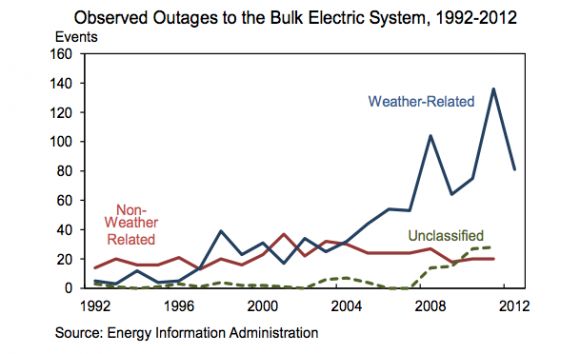The need to modernize and protect the electric grid has never been greater.
Since 2004, seven of the ten most expensive storms in history have battered the U.S., increasing grid outages. Last year, America experienced eleven outages costing more than $1 billion, reducing economic activity by between $27 billion and $52 billion. (In 2004, the Lawrence Berkeley National Lab estimated that yearly blackouts caused up to $80 billion in economic losses each year.)
Since 2002, 58 percent of outages have been caused by extreme weather. And as the planet warms and storms continue to get more powerful, an electric grid based on outdated technologies will be increasingly inadequate to handle the onslaught of violent and expensive weather events.
That's the conclusion of a new report released today by the White House calling for an increase in funding to "harden" the grid.
"Severe weather is the number-one cause of power outages in the United States and costs the economy billions of dollars a year in lost output and wages, spoiled inventory, delayed production, inconvenience and damage to grid infrastructure," wrote the President's Council of Economic Advisors. "Grid resilience is increasingly important as climate change increases the frequency and intensity of severe weather."
For an illustration of how the problem is increasing, take a look at this chart from the Energy Information Administration showing outage trends:

The White House report illustrates a shift in messaging over the last year, as advocates move away from the squishy term "smart grid" to more concrete terms like "grid modernization" and "grid resiliency." The phrase "smart grid" is sparsely mentioned in the analysis.
The White House recommendations for resiliency are similar to those issued by the GridWise Alliance earlier this summer in an analysis of utility preparedness after Superstorm Sandy. They include developing better risk management procedures to plan for storms; moving substations and equipment out of flood zones; strengthening buildings in vulnerable areas; constructing new transmission lines, microgrids and battery storage projects; and deploying more smart meters, synchrophasors and automated feeder switches to provide more situational awareness and reroute power when needed.
The report follows a July memo from President Obama directing agency heads to finalize plans for implementing new transmission corridors as part of a grid modernization plan. It is one of many resources the Obama administration has released since crafting a smart grid policy framework in 2011.
Since 2011, the administration has set aside billions of dollars to deploy smart grid technologies. Although the Department of Energy has reported $6.8 billion in economic activity from $2.96 billion invested in the sector, there are still questions about whether the stimulus-era boost will sustain momentum in the long term. The next round of investments will need to come primarily from utilities, and it is unclear whether utilities are prepared to spend the tens (or hundreds) of billions more needed to make the grid more resilient.
Some utilities are boosting their efforts, particularly as extreme weather gets worse. New Jersey's PSE&G, a utility hit hard by Superstorm Sandy, recently announced a proposal to spend $4 billion for modernizing its electricity and gas infrastructure.
However, the White House report concludes that utilities are still not spending nearly what they should to prepare for coming storms -- failing even to match investment levels from the three decades between 1960 and 1990.



